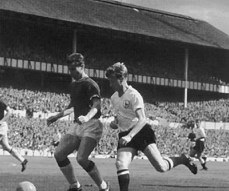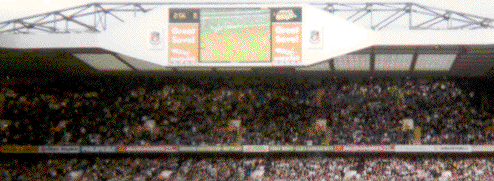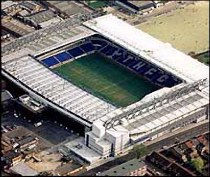
White Hart Lane
Pictures
|
When you think of great stadiums, you automatically think of White Hart Lane, the home of Tottenham Hotspur. Over the years many great games have been witnessed, many great players have shone and much excitment has been had at one of Britains most finest and famous stadiums
Having Played football at Tottenham Marshes and then at Northumberland park,the club moved to its present site in 1899. It was at 750 High Road , in a former nursery set up by Landlord George Backwith.The ground at that time was simply made up of mobile stands that could be moved around the ground and that had a capaciy of about 2,500. The ground was originally to be known as 'Percy Park' known as what it is today - White Hart Lane.
The stands were doubled to 5000 in September, at a friendly match against N. County in Which Spurs won 4 - 1. The stadium began to constantly grow some five years after the club's move, with the capacity reaching around 30,000 of which only 500 were seats
The needs for a larger ground and stadium, however, were obvious as the following of the clubs was steadily increasing after having managed to climb to the first division. Plans were now made for a new stand. This had seating capacity of 5300 against previously only 500, and was opened on September 11th, 1909.
Over the time to come, the capacity at the White Hart Lane steadily increased. The east stand was rebuilt in 1934, had a capacity of 5100 seats and 18700 stands. This made the White Hart Lane's total capacity to some 80 000. In 1921 the club took over the red house at the front of the ground. This became new club office.

The Lane In The Early Days
In 1937 the club registered offices moved from 750 High Road to 748 High Road. Floodlights first saw the light of day in 1953. These were steadily upgraded, first in 1957, then when floodlight pylons were mounted in 1961. At this time the seating capacity was 2600. In 1963 the stand at Paxton road underwent a refurbishing and 3500 seats were installed.
Now the Paxton stand was linked with the east stand, this resulted in another 1400 seats. In 1972 a new modern floodlight system appeared. A year later the south and west stands were linked up with an additional 700 seats. The old west stand was teared down in 1980. A replacement structure was finalized 15 months later and that new West Stand still remains today
The floodlight pylons were replaced in 1989 by new spotlights on the east and west stands.
In 1993 the lower north terrace was converted to an all-seated area with its roof built to link up with the east and west stands, giving the stadium a more compact feeling and also increasing the atmosphere.
In 1995 the new south stand was completed with the big telly screen known as the 'jumbeton'. Now all stands had been linked to give a wrap-around effect trough the stadium. Four new, modern lounges and restaurants on first, third and fourth levels were introduced in the summer of 1996.
The summer of 97 saw the finally piece of the jigsaw added to White White Lane, with the new North stand off similar size and shape to that of the South stand, with a jumbeton also addded to give everyone in the ground a view of all the action.

The New North Stand That Was Opened At The End Of The 97/98 Season
With the capacity lying at 36,058, relativey small compared with the Lane of the 60's, plans are thought to be in progress to re-design the east stand to bring the capacity up to 44,000, but whatever the case White Hart lane will remain close to all Spurs fans.

The Lane From Above